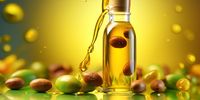Biosources as alternative raw materials for fossil and synthetic hydrocarbons
In recent years, there has been an increasing endeavour to replace fossil products with products based on renewable sources in order to reduce the burden on the environment. Sustainability has become the big buzzword.
Essentially, however, the aim is to reduce the consumption of mineral oil hydrocarbons, which are used as fuels and heat suppliers, in order to minimise CO2 emissions.
On the other hand, there is also the approach of replacing petrochemical products with biorefinery processes. The requirements for products from the mineral oil and petrochemical industries are clearly defined, as they determine their suitability for further processing into other products (e.g. plastics, lubricants, cosmetic and pharmaceutical products, etc.). A key feature of these products is their chemical and thermal stability, which mainly depends on the starting products being free of chemical by-products and chemically unstable reaction products. These impurities not only have an influence on the stability of the product, but in some cases also affect its toxicological and ecotoxicological properties.
Much progress has already been made in the production of solvents (Clarke et al. 2018; Sheldon 2014) and basic chemicals, although one challenge here is to produce the volumes required on an industrial scale. The economic viability also depends on the chemical and thermal purification processes required to produce the substances. The higher the quality requirements for their use, the more demanding the purification of these products becomes. For products used in pharmaceuticals or cosmetics in particular, for example, biological by-products such as proteins, peptides, genetic material (from the renewable resource itself or from fermenting, genetically modified organisms) or phytohormones must be removed.
A significant simplification in the production of bio-source products is when an intermediate product can be separated into the gas phase. Here, for example, iso-butene is produced in a process from iso-butanol obtained by fermentation. This enables complete separation from the feedstock. The iso-butene is oligomerised to iso-paraffinic hydrocarbons, which can be used as emollients in cosmetics, for example.
The innovation in the areas of application mentioned is very high, but it should not be forgotten that attention must also be paid to the toxicological properties of the products that are produced using complex processes. There will still be many regulatory hurdles to overcome in the future. Time and again, new products (as well as products that have been known for some time) come into the focus of "substances of very high concern". Natural substances on a terpenoid basis also show suspicious signs of adverse effects in the body or in nature in computer-aided QSAR* analyses. Terpenoid basic structures in plants and living organisms are intended to function as messenger substances or cellular building blocks and can develop such an effect again through enzymatic reactivation. Recently, the screening of substances that show very poor biodegradability (bioaccumulation) or are suspected endocrine disruptors has been intensified. It should also be borne in mind that some substances only become toxic through enzymatic action in nature and in the body.
For this reason, it may be worthwhile carrying out subchronic or chronic toxicological tests in advance, which provide information about the substance's longer duration of action.
Unfortunately, "sustainability" alone is not enough for the carefree use of products made from new resources.
The safety of the manufactured products must also be proven.
*QSAR - Quantitative Structure-Activity Relationship
Further sources of information :
RoadToBio
BioSC
Literature
Clarke, Coby J.; Tu, Wei-Chien; Levers, Oliver; Bröhl, Andreas; Hallett, Jason P. (2018): Green and Sustainable Solvents in Chemical Processes. In: Chemical reviews 118 (2), S. 747–800. DOI: 10.1021/acs.chemrev.7b00571.
Hancsók, Jenő; Eller, Zoltán; Pölczmann, György; Varga, Zoltán; Holló, András; Varga, Géza (2014): Sustainable production of bioparaffins in a crude oil refinery. In: Clean Techn Environ Policy 16 (7), S. 1445–1454. DOI: 10.1007/s10098-014-0743-6.
Romsdahl, Trevor; Shirani, Asghar; Minto, Robert E.; Zhang, Chunyu; Cahoon, Edgar B.; Chapman, Kent D.; Berman, Diana (2019): Nature-Guided Synthesis of Advanced Bio-Lubricants. In: Scientific reports 9 (1), S. 11711. DOI: 10.1038/s41598-019-48165-6.
Sheldon, Roger A. (2014): Green and sustainable manufacture of chemicals from biomass: state of the art. In: Green Chem 16 (3), S. 950–963. DOI: 10.1039/C3GC41935E.
